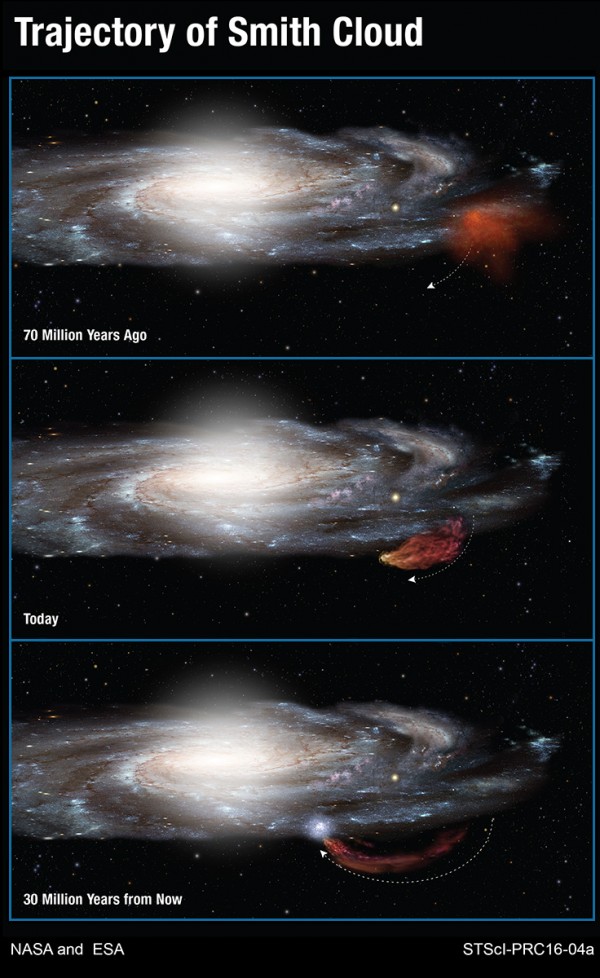By Ana Verayo, | January 29, 2016

This diagram shows the 100-million-year-long trajectory of the Smith Cloud as it arcs out of the plane of our Milky Way galaxy and then returns like a boomerang
A massive cosmic cloud of gas that is now headed towards the Milky Way galaxy at speeds of 700,000 miles per hour. This sulfur gas cloud is so colossal in galactic terms that it measures 11,000 light years long and 2,500 light years wide, possessing a mass of a million suns which already existed during the Jurassic era.
Like Us on Facebook
Apparently, this cloud has been blasted off from our galaxy some 70 million years ago. Astronomers already know about the "Smith Cloud" since 1963 and now, scientists have been monitoring this monster cosmic cloud at the National Radio Astronomy Observatory's Green Bank Observatory and more recently, the Hubble Space Telescope, as it is has been identified containing heavy elements like sulfur.
Its origin, based on its arc-shaped trajectory indicates that this cloud travelled from a dense star filled region along the edges of the Milky Way.
According to Andrew Fox from the Space Telescope Science Institute, this cloud is an indication how the galaxy is now changing through time, where it is telling us that the Milky Way is still an active place, bubbling with gas that can be thrown out of a disk and bounce back from another.
Although shaped liked a comet, the Smith Cloud has no stars and it is also not directly observable with the naked eye or via optical wavelengths. Astronomers believe that if this cloud was visible, it would cover a huge region of the night sky similar to the Orion constellation.
This cloud is travelling at tremendously high velocities however, it will take another 30 million years to hit the disc of the galaxy, on another region of the Milky Way, which is far from the region of our solar system.
The cloud impact will ignite an explosion of star formation around the site with enough energy and stellar fuel to create 2 million stars similar to our sun. Fox says that the galaxy has been recycling gas clouds which includes the Smith Cloud, where it will form new stars in different regions from before. With the help of the Hubble, important data can be known about the disk activity of galaxies.
To date, it is still unknown what exactly caused this cloud ejection. According to co-author of the study, Jay Lockman from the National Radio Astronomy Observatory, who has been tracking the Smith Cloud for a long time now, theories involve that a dark matter satellite can capture gas when this cloud passes through the Milky Way disk.
This new study is published in The Astrophysical Journal Letters.
-
Use of Coronavirus Pandemic Drones Raises Privacy Concerns: Drones Spread Fear, Local Officials Say

-
Coronavirus Hampers The Delivery Of Lockheed Martin F-35 Stealth Fighters For 2020

-
Instagram Speeds Up Plans to Add Account Memorialization Feature Due to COVID-19 Deaths

-
NASA: Perseverance Plans to Bring 'Mars Rock' to Earth in 2031

-
600 Dead And 3,000 In The Hospital as Iranians Believed Drinking High-Concentrations of Alcohol Can Cure The Coronavirus

-
600 Dead And 3,000 In The Hospital as Iranians Believed Drinking High-Concentrations of Alcohol Can Cure The Coronavirus

-
COVID-19: Doctors, Nurses Use Virtual Reality to Learn New Skills in Treating Coronavirus Patients







